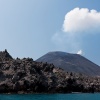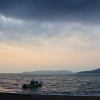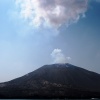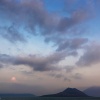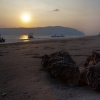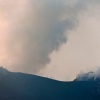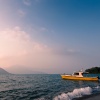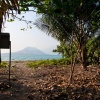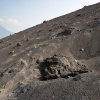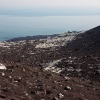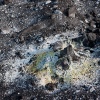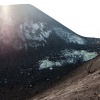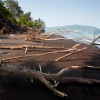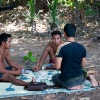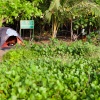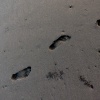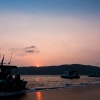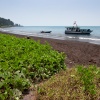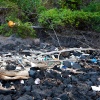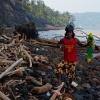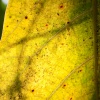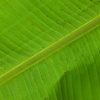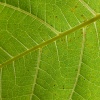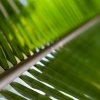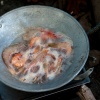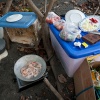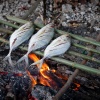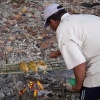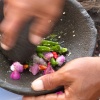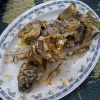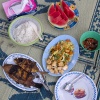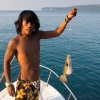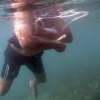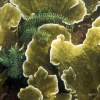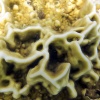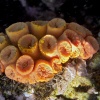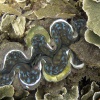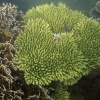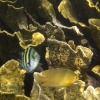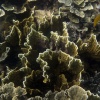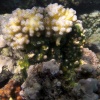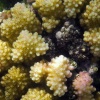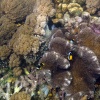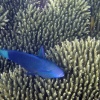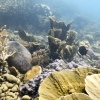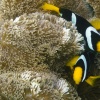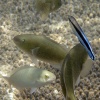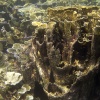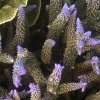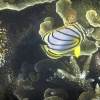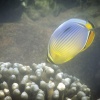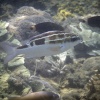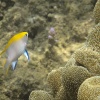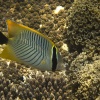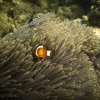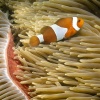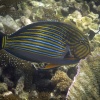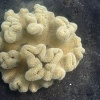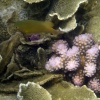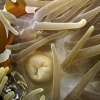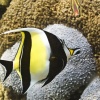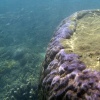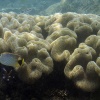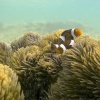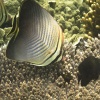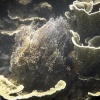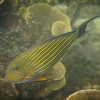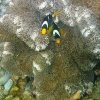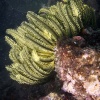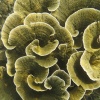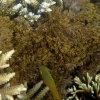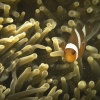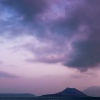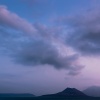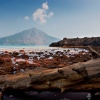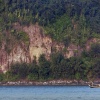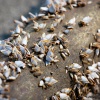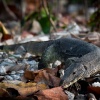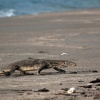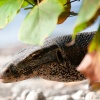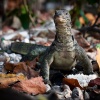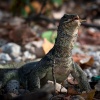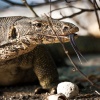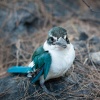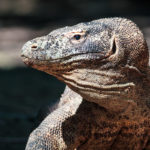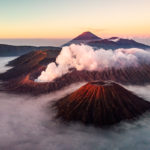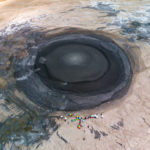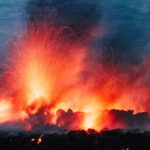Sunda – The Fire Mountain Strait
When magma – normally being covered by the Earth’s mantle – comes to light and shakes hands with water, experts only speaks of a phreatomagmatic eruption slightly subcooled, whereas the world we know is confronted with an explosive force that can be several hundred Hiroshima bombs strong. In the year 1883 such a volcanic eruption of epic proportions occurred. Over 20km3 rocks and ashes were catapulted up to 25km high and a tsunami up to 40 meters high swept the villages on the surrounding islands off the map. The place of this catastrophe was the Indonesian archipelago, more precisely the Sunda Strait between Sumatra and Java, where today the descendant of the once exploded Feuerberg is already in the starting blocks and regularly sends new eruptions into the sky: The Anak Krakatoa, to whom life gradually returns, especially under water.
The sea is rough, but the wind has no share this time. The Indonesian archipelago lies between the Pacific and Indian Oceans. The elemental currents that occur there can be life-threatening for divers, swimmers and hobby captains above and under water. They simply sweep you away into the depths, never to be seen again… The small nut shell that brings me from Carita to the Sunda Strait archipelago of the volcano Krakatoa is rocked by the swell. Käpt’n, who always felt that the whole trip was only adequately addressed with Käpt’n, steered the bow with masterly precision always frontally onto the wave crests, so that everything in the boat including passengers jumps up and crashes back onto the deck. Fortunately the topic of seasickness has been around since I was five years old, but this rocking takes getting used to and definitely leaves bruises.
The Indonesian word Anak means as much as descendant, pupil or child and that the apple does not fall far from the tribe even in the volcanic sense, Anak Krakatoa, who grows up directly in the caldera of his predecessor, proves every day anew, normally. For the duration of my stay, the mountain of fire took a short break and sent nothing but thick clouds of its rotten breath into the sky. Ideal conditions for an ascent, actually. Immediate danger, however, came from a glowing lava plug that closed the vent. The volcano could have blown itself free at any time.
The ascent to the crater of the Krakatoa degenerated into a crawl… Several meters above me were a few Frenchmen on the way who had no idea how to behave on the mountain. They kicked rocks loose and so razor-sharp lava rocks rumbled down on me and cut my clothes within few minutes. Putting on a helmet turned out to be a life insurance in no time at all. Much worse, however, were the hot gas outlets that suddenly appeared on the slope. This means fresh holes in the rock from which hot gas shoots out. Unfortunately not all of these holes could be identified immediately by the heat flickering, so that burns were pre-programmed. In such a maltreated way I decided to leave the Krakatoa Krakatoa on half way after about 2 hours in the Glimme and not to climb it, especially as the climbers in front started to kick off the one or other small scree avalanche out of ignorance.
If you have to make a long journey because of the fire-breathing activity, then it is a pity to have little or no activity at first, but after the aborted ascent there was enough time to explore the islands extensively, snorkel and admire the fauna and flora that have returned to this volcanic place.
The waters around the Krakatoa are, apart from the strong currents, not only excellent diving but also fishing grounds. I don’t know what kind of fish went to Digimon’s companion and my fishing rod (tendon with fishing hook) every minute, the gutting at least resembled the dissection of the Roswell Aliens. But all the fish were just damn delicious. In shortest time we fetched no less than 4 kilograms of freshly caught fish from the floods which were then immediately grilled on the black beach over the open campfire.
The volcano seemed to be inspired by the smoke of our fire and released exhalations that could be easily smelled 1-2 kilometres away. Smell or not, in the light of dawn and dusk volcanic gases and fine ash particles draw the finest surreal colours into the sky and create a romantic atmosphere from which even the most militant fantasy opponents cannot escape. Strengthened with fish and optically spoiled, it fell asleep wonderfully under the open starry sky and not far from the volcano. By the way, you can camp on the islands Sertung, Rakata or directly on the volcano island. By the way, the arrangement, location and diameter of the small archipelago comprising four islands suggest the former extension of the former Krakatoa.
Fishing was already a clear indicator for the abundance of fish in the volcanic island archipelago and even at the rugged rocky foot of the volcano the density of submarine fauna is surprisingly high. If you dive down, you immediately notice the underwater crystallized, poisonous yellow and rock-hard sulfur structures. Surprisingly even these are considered by soft corals and sponges with the housing search and populated sooner or later. Most creepy, however, are the soft corals that settle directly on the black seabed, which look like an army of many human brains wobbling in the water.
The underwater gardens at the foot of the large Rakata rock island, however, the largest remnant of the once exploded volcano, are the most beautiful. The abundance of fish there is so high and diverse that a sushi cook loosely gets wet dreams. With a little luck, you might spot some goldtail anemonefs in one or the other anemone further out, fighting the current with excitement as they grumpyly gaze at the snorkeler as he dives down again and again.
Further along the shore, in shallower waters, one of the most famous fish of all is at home and with a little luck you will discover him, Nemo. Unfortunately, Disney’s animated film made sure that the clownfish Nemo & Marlin shown in the film were not assigned to the scientifically correct title False Clownfish. A real clownfish at least differs from the cartoon character e.g. in the fin shape. Anyway, the joy is great when you see the little boys scurrying around and they surf through the tentacles of the anemone like Kelly Slater. More clownfish and anemone fish can be seen here.
Another characteristic of Anak Krakatoa is its tendency to Phreatomagmatism which can be found in pumice stone, which is distributed in thousands as white and black porous stone on all islands of the small archipelago. It is formed when smaller lava fragments are foamed up by contact with water (steam) and the gas contained in them is released. Chemically, pumice does not differ much from real lava, but due to its low density it is much lighter and can even swim. This is not the case with the lava bombs found on the volcanic island. They are massive through and through and partly so big that small Digimon can hide almost completely in a crater hit by a bomb. If such a lump bangs on the twelve, no doctor needs to be called anymore.
The Krakatoa Archipelago is a national park. On the rather quiet northern side of the volcanic island the rangers have taken up position. The machine pistol is casually clamped into a branch fork and they enjoy themselves in seemingly endless card games. I would have loved to play a round of skat with them, but how do you teach an Indonesian how to be attractive? It was easy to teach them Mau-Mau and I am sure that this round is still playing Mau-Mau at the foot of the Krakatoa, on the other side of the world, and Käpt’n growls through his gap in his teeth, when he has just been given a 7 or an ace by the other side.
After four days at the volcano, countless underwater experiences, lots of grilled fish and even more card games, the boat steers Käpt’n back through the waves to Carita, the starting point for trips to Anak Krakatoa. So you can experience a volcano and its nature in a different way.
